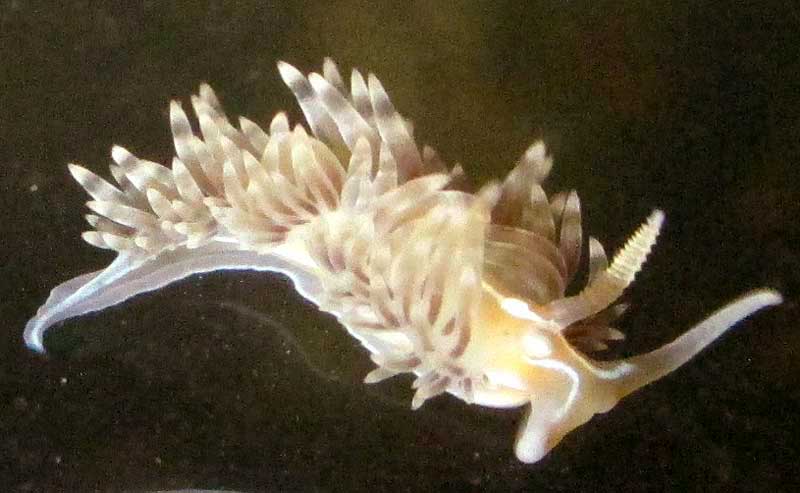Excerpts from Jim Conrad's
Naturalist Newsletter

from the March 15, 2015 Newsletter issued from Río Lagartos, on the Yucatan Peninsula's northern coast (~N21.60°, ~W88.16°), Yucatán state, MÉXICO
SEA SLUG/ NUDIBRANCH
Some of the most amazing occupants of our new aquarium in Diego's restaurant/ecotour headquarters are introduced incidentally, especially when we add macroalga-encrusted rocks. Leafy rock algae constitute jungles in which the smaller inhabitants only occasionally show themselves, and sometimes what emerges draws a crowd of folks who never dreamed such exotic life forms could exist in our local waters. One such little being was the 3/8ths-inch long (1cm) critter that turned up one night on the aquarium's glass wall near the water's surface, shown above.
Though I've never seen such a thing in the wild, often in books I'd run across pictures of similar creatures. They're nudibranchs -- "nudibranchs" being the preferred plural form, and the end "ch" pronounced like a k instead of how it looks. Nudibranchs are a kind of gastropod (snail-like) mollusk. In fact, from outside the aquarium, the nudibranch's underside as it skims over the glass's inside surface looks just like that of a snail, but a snail without a shell. The shell is replaced by slender, fleshy, fingerlike appendages. Another shot of the above individual, better showing the curve-tipped, bull-horn-like tentacles at the front, and stiff, ringed, sharp-pointed, goat-horn-like "rhinophores" above the tentacles, appears below:

Rhinophores are chemical-sensing organs, or "chemosensors," used mostly to inform the nudibranch as to what kind of environment it's in, and what kind of food is thereabouts. The fleshy, fingerlike things on the back are "cerata," the main function of which is to simply increase the nudibranch's body surface-area. The nudibranch has no lungs, so its oxygen simply diffuses from surrounding water into the body, meaning that the more body surface area it has, the more oxygen can enter its body.
Despite our nudibranch's bland, creamy color, nudibranchs in general are thought of as among the most colorful creatures on earth. One explanation for their wild colors is that during the course of evolution they traded their typical mollusk shells for more sophisticated defense mechanisms. Some species evolved forms, colors and textures mimicking surrounding sponges or corals. Others developed intensely bright and contrasting color patterns, believed to warn potential predators that they are distasteful or poisonous.
Best I can tell from photos on the Internet, our nudibranch is DONDICE PARGUERENSIS, not known well enough to have a common name, and distributed in the Caribbean area. Something remarkable about Dondice parguerensis is that it's thought to be entirely parasitic on Upside-down Jellyfish, a species of which we've admired at www.backyardnature.net/yucatan/cassiope.htm.
Another species of Dondice found in the Caribbean area, Dondice occidentalis, only eats anemones. Other than their different feeding behaviors, these two species are so similar morphologically that some experts believe they may actually be the same species occupying different ecological niches. Current genetic studies are expected to clarify the issue.
When threatened by predators, jellyfish shoot hundreds of stinging, arrowlike "nematocysts" into surrounding water. However, Dondice parguerensis, who lives in a jellyfish, is immune to such nematocysts. Moreover, by living in a jellyfish, it not only "lives in its food" but also is protected from predators by the jellyfish's stinging nematocysts. As far as is known, this is a strictly parasitic relationship, the jellyfish not benefiting from the nudibranch's presence in any way.